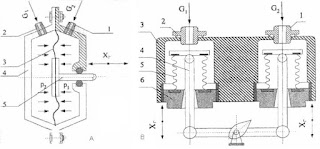Different kinds of Pneumatic Actuators
Classification of pneumatic actuators
A set of devices into with one or more pneumoengines, which are determined to start mechanisms
or some other objects by means of pressed working gas is called pneumatic actuator,
or pneumoactuator.
The devices intended for transformation of potential and kinetic energy of the stream of
compressed gas in mechanical energy of the output link that can be, for example, a rod of the
piston, a shaft of the turbine or the case of the jet device is called pneumatic engines of the
automated actuator.
All pneumatic actuators can be subdivided into the following types:
• diaphragm pneumatic actuators;
• pneumatic power cylinders;
• gas-engine pneumatic actuators;
• turbine pneumatic actuators;
• jet-stream pneumatic actuators;
• pneumomuscles;
• combined pneumatic actuators.
The principle of transformation of potential or kinetic energy of the gas stream into mechanical
energy of the engine output link of the engine provide the base for division into types.
Diaphragm pneumatic actuators
Diaphragm pneumatic actuators include membrane and sylphon pneumoactuators. Potential
energy of gas stream, i.e. energy of static pressure is used in diaphragm pneumatic actuators.
The difference of static pressure in receivers of the actuator transformes into the effort on the
output element of the drive - the rod. Pneumatic actuators can be executed both on one-sided
(not reversive), and on double-sided (reversive) scheme.
The basic scheme of the membrane pneumatic actuator is shown in figure 2 A.
Work of the pneumatic actuator consists in moving of a rod under influence of the difference
of pressure p1 − p2 in cavities that is formed due to the difference of gas charges G1 − G2.
The sylphon pneumatic engine functions by the same principle. Its scheme is shown in
figure 2 B.
Pneumatic power cylinders
Air, or pneumatic cylinders are devices that convert power of compressed air into mechanical
energy. This mechanical energy produces linear or rotary motion. In this way, the air cylinder
functions as the actuator in the pneumatic system, so it is also known as a pneumatic linear
actuator.
Devices with forward linear movement are divided into single-acting and double-acting
pneumocylinders, with rod and rodless. Rod pneumocylinders in turn can have a through-pass
or a no-go rod. Devices with rotary (rotational) movement are divided into pneumocylinders
with rotary movement of the output link and rotational pneumocylinders.
Structurally pneumatic power cylinders can be piston, membrane, sylphon and hose.
The air cylinder consists of steel or stainless steel piston, piston rod, cylinder barrel and
end covers.
In piston pneumatic cylinders, as well as in diaphragm, potential energy of the compressed
gas is used, but presence of the piston with mobile condensation allows to reach big movings
of the output link.
As compressed air moves into the cylinder, it pushes the piston along the length of the
cylinder. Compressed air or the spring, located at the rod end of the cylinder, pushes the
piston back.
For compression a cuff from elastic material is installed into the rod in a cover of the
cylinder. The bush serving as direction for the rod, allows to increase the allowable crosssection
effort of the loading on to the rod, especially for big lengths. The ring that prevents
dust and firm particles hitting the cylinder is inserted into the cover, in front of the bush.
Volume changing of the working cavities is into proportionally to the moving of the rod. Thus,
the additional volume can be reductioned to a minimum, determined only by the volume of
the pipelines.
Some form of cushioning is normally required to reduce the rate of the cylinder travel before
the piston strikes the end cover. Reducing the piston velocity at the end of its travel lowers the
stresses on the cylinder while reducing vibration in the structure of which it is part. Efficient
cushioning is usually necessary in applications, in which precision is required. Basically,
this problem can be solved in one of three ways: by means of simple impact cushioning,
by pneumatic cushioning or by fitting shock absorbers.
Valves control the flow of compressed air to the cylinder.
Different types of cylinders include standard, short-run, flat, rodless, rotary cylinders.
The two basic types of standard air cylinders, based on their performance, are as follows:
single acting and double acting. The single acting cylinder is able to perform an operating
motion in only one direction.
Ram cylinder - a cylinder in which the movable element is the piston rod.
A double acting pneumatic cylinder — has two-directed powered motion in, with pressure
on both sides.
When a cylinder is pushed out in one direction, compressed air moves it back in the
opposite direction. Air lines running into both ends of the cylinder supply the compressed
air. The flow of the compressed air is controlled with valves both in single- and double-acting
cylinders.
Spring return cylinder - a cylinder in which a spring returns the piston assembly.
A single acting - spring return air cylinder - has air pressure on one side of the piston flange,
supplying force and motion, and the spring supplying the return force after the pressure release.
Single acting cylinders require approximately a half of the amount of the air used by a double
acting cylinder for a single operating cycle.
Double-acting double-rod cylinder - double-acting cylinder with a piston rod extending
form each end. The piston rods are connected with the same piston. Double rod cylinders
provide equal force and speed in both directions.
Double acting with magnetic piston according to DIN ISO 6431/VDMA 24562 (cylinders
with piston rod on both sides)
